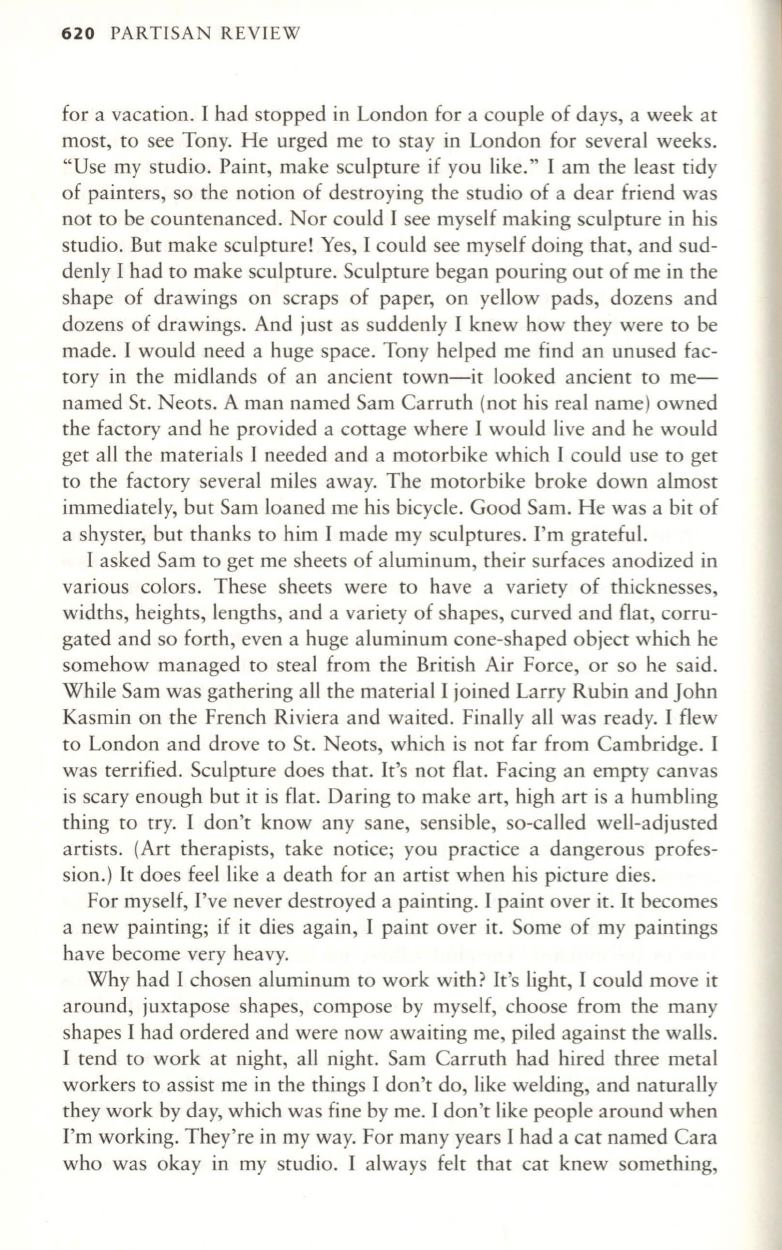
6 2 0
PARTISAN REVIEW
for a vacation. I had stopped in London for a couple of days, a week at
most, to see Tony. He urged me to stay in London for several weeks.
"Use my studio. Paint, make sculpture if you like." I am the least tidy
of painters, so the notion of destroying the studio of a dear friend was
not to be countenanced. Nor could I see myself making sculpture in his
studio. But make sculpture! Yes, I could see myself doing that, and sud–
denly I had to make sculpture. Sculpture began pouring out of me in the
shape of drawings on scraps of paper, on yellow pads, dozens and
dozens of drawings . And just as suddenly I knew how they were to be
made. I would need a huge space. Tony helped me find an unused fac–
tory in the midlands of an ancient town-it looked ancient to me–
named St. Neots. A man named Sam Carruth (not his real name) owned
the factory and he provided a cottage where I would live and he would
get all the materials I needed and a motorbike which I could use to get
to the factory several miles away. The motorbike broke down almost
immediately, but Sam loaned me his bicycle. Good Sam. He was a bit of
a shyster, but thanks to him I made my sculptures. I'm grateful.
I asked Sam to get me sheets of aluminum, their surfaces anodized in
various colors. These sheets were to have a variety of thicknesses,
widths, heights, lengths, and a variety of shapes, curved and flat, corru–
gated and so forth, even a huge aluminum cone-shaped object which he
somehow managed to steal from the British Air Force, or so he said.
While Sam was gathering all the material I joined Larry Rubin and John
Kasmin on the French Riviera and waited . Finally all was ready. I flew
to London and drove to St. Neots, which is not far from Cambridge. I
was terrified. Sculpture does that. It's not flat. Facing an empty canvas
is scary enough but it is flat. Daring to make art, high art is a humbling
thing to try. I don't know any sane, sensible, so-called well-adjusted
artists. (Art therapists, take notice; you practice a dangerous profes–
sion.) It does feel like a death for an artist when his picture dies.
For myself, I've never destroyed a painting. I paint over it. It becomes
a new painting; if it dies again, I paint over it. Some of my paintings
have become very heavy.
Why had I chosen aluminum to work with? It's light, I could move it
around, juxtapose shapes, compose by myself, choose from the many
shapes I had ordered and were now awaiting me, piled against the walls.
I tend to work at night, all night. Sam Carruth had hired three metal
workers to assist me in the things I don't do, like welding, and naturally
they work by day, which was fine by me. I don't like people around when
I'm working. They're in my way. For many years I had a cat named Cara
who was okay in my studio. I always felt that cat knew something,


